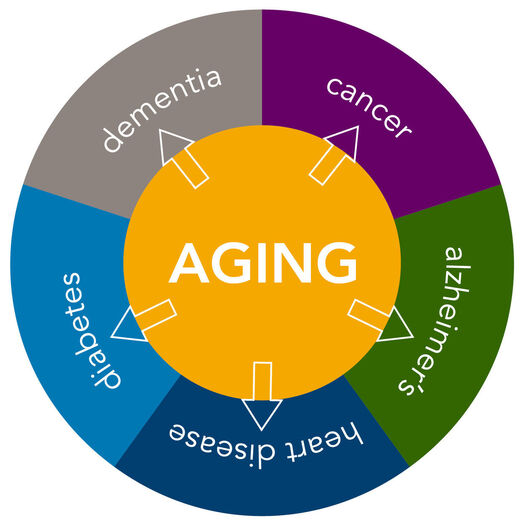Jul
28

Posted by NNLM Region 7 on July 28th, 2020
Posted in: NIH, NLM Resources
A term keeps popping up around the NIH and NLM; Geroscience.
The meaning may be obvious if you understand the parts of the word; gero- in medicine is a prefix indicating the association with old age or aging, and science – the study of something. But that doesn’t really get to the heart of what Geroscience is.
The National Institute on Aging (NIA) has been tackling this topic. In an article, Geroscience: The intersection of basic aging biology, chronic disease, and health, the question is raised, “How does the aging process affect the disease process and susceptibility—and vice versa?” In detail answering, ”Geroscience… seek[s] to understand the genetic, molecular, and cellular mechanisms that make aging a major risk factor and driver of common chronic conditions and diseases of older people.”
Geroscience is a NIH-wide initiative. The Trans-NIH Geroscience Interest Group (GSIG) was formed in 2012 with the goal of stimulating interest and involvement in the basic science of aging across Institutes, Centers, and Offices at NIH. Summits have been held, working groups formed, and much more collaborative work has demonstrated the impact of studying aging in this new way. In an article in Cell they call for geroscience to merge with ongoing research on human chronic disease states, compare and contrast inflammation in aging and disease, and develop new animal models of aging, among other recommendations.
The American Federation for Aging Research advocates that, “By treating aging – not just age related disease – we can stay healthy longer.” Their hypothesis is, ” since aging physiology plays a major role in many — if not all — chronic diseases, therapeutically addressing aging physiology directly will prevent the onset or mitigate the severity of multiple chronic diseases.” With the goal of, “develop[ing] feasible, practical, and safe interventions to delay the appearance of multiple chronic diseases and conditions. Interventions that slow the aging processes would dramatically lower health care costs, perhaps more than the cure of any single disease, while significantly improving quality of life.”
So what is next? By 2050, approximately one-quarter of the world’s population will be over 60 years of age. Growing acknowledgement of the issue and growing research around the topic are successfully introducing new fields to the concept. Geroscience is moving beyond the traditional aliments of old age like cancer, diabetes, Alzheimer’s, and cardiovascular disease. There are areas of musculoskeletal diseases and oral health that have arisen as issues in aging. As the NIA puts it, “The ultimate goal of geroscience is to accelerate research into the basic mechanisms driving aging, which could lead to improved clinical interventions. Toward that goal, the GSIG remains focused on discovering the basic biology at the intersection among aging, chronic disease, frailty, and resilience. Basic biology renders the process of aging the major risk factor for the age-related decline in health, threatening an increasingly older population.”
Links and Resources
American Federation for Aging Research – What is Geroscience? Connecting the Biology of Aging and the Biology of Disease https://www.afar.org/what-is-geroscience
Cell – Geroscience: Linking Aging to Chronic Disease https://www.sciencedirect.com/science/article/pii/S009286741401366X
National Institute on Aging: Geroscience: The intersection of basic aging biology, chronic disease, and health https://www.nia.nih.gov/research/dab/geroscience-intersection-basic-aging-biology-chronic-disease-and-health
Penn Medicine News: Geroscience? Much More Than a Reaction to the “Silver Tsunami” https://www.pennmedicine.org/news/news-blog/2014/november/geroscience-much-more-than-a-r